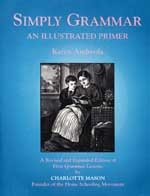Simply Grammar is an ungraded resource book for teaching grammar. It is a modernized version of Charlotte Mason's original book published in 1928. According to Mason's philosophy, grammar is not taught directly until around fourth grade. Thus, this book is written for students in grades 4-8. However, I expect that many third graders will be ready for these lessons. Simply Grammar also works especially well for those who have just completed English for the Thoughtful Child.
It utilizes much more oral work than written, implementing Mason's method of teaching through narration. (Narration means that children describe, explain, summarize, and relate as a primary means of developing language art skills.) Simply Grammar features 50 full-page, nineteenth-century illustrations that are used as subjects for learning. For example, one illustration shows a mother, her daughter, and an infant. Students are told, "Deborah is a helper. Look at the picture on page 44 and make six sentences, with the verb in the present tense or time." There are some fill-in-the-blank questions and some requiring brief answers, but these should be done orally or on separate paper, since this book is not intended to be consumable.
Some of the language sounds "young" for eighth graders, but the grammar content is sufficient through junior high level. It includes sentences, subjects, predicates, nouns, verbs, adjectives, prepositions, adverbs, pronouns (all the various types), conjunctions, interjections, subject/verb agreement, number, cases, tenses, and moods. Some additional practice exercises and an answer key are at the back of the book. The print is large and uncrowded.
Obviously, there is not as much practice and drill here as in grammar programs that have new books for each year, but remember that those books cover essentially the same material over and over. If you begin in this book in fourth grade, remember that your child need not learn all of the lessons in a single year. In fact, he or she probably needs to wait a few years before tackling questions like, "Give the person, number, and gender of the relative pronoun in given sentences...." (p. 148). If you want more practice or review than is provided here, supplement with Daily Grams.
The foregoing description fails to capture the emotional warmth of this book. The delightful pictures, trailing-vine page borders, and the gentle approach give a distinctly different flavor than typical grammar books. The publisher will send sample pages to those who send along two first-class postage stamps with their request.









